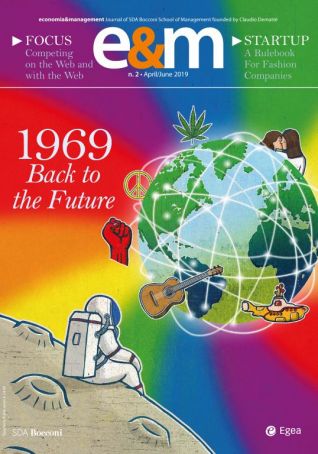E&M
2019/2
Celebrating Heroes: On Rewards in Corporations
Download article as PDFA fundamental part of our social life is based on the universal need to have the respect, esteem and approval of the people around us. Public prizes and awards are some of the instruments that carry out this important social function. Initially limited to situations outside of employment fields not driven by commercial logic (sports, culture, civil and military valor), prizes and public awards of various kinds have also spread increasingly into businesses with regard to their employees. As witnessed by the photos and "employee of the month" lists that many companies celebrate and post in their workplaces, or the prizes that are periodically awarded in certain company events, public awards have been transformed from instruments reserved for "out of the ordinary" situations, to mark "exceptional" behavior or results, to a permanent mechanism of the "ordinary" working world.[1]
Perhaps because they are perceived as apparently simple instruments to introduce and cheap to implement (a photo, a plaque, a simple ceremony during the various corporate events or occasions) these kinds of programs have become quite widespread, without many companies being fully aware of the errors of "translation" compared with the traditional situations where such awards originated, and of the distortions that they can create in the work situations where they are adopted. Indeed, a recent study pointed out that the introduction of a reward for employee punctuality in a laundry not only gave rise to opportunistic behavior, but even had a negative impact on the performance of the employees who had been the most punctual before the program was set up. These employees felt it was unfair to consider as worthy of recognition those who had instrumentally modified their behavior, rather than to see punctuality as a quality that should not be a part of this calculation.[2] Introduced with the intention of increasing the motivation of employees, their identification with corporate goals, and ultimately, their performance, these instruments can turn out to be equally powerful in inducing undesirable behavior and effects. We therefore need to understand the social functions and mechanisms behind them.
The prizes and formal recognitions awarded to single individuals are characterized as public announcements, for the purpose of communicating the importance and prestige of a given activity to a more or less wide group of people. This involves identifying features, whose economic value – if it exists – is insignificant or marginal, but which can have a very high symbolic value. Not all activities or social contexts lend themselves to the introduction of these forms of recognition. As pointed out above, traditionally they were used in extra-economic situations (sports, literary or artistic prizes, for scientific achievement, or recognition of civil or military valor). These are situations not subject to contractual relationships, that in fact reject such a logic. Activities worthy of attention and recognition must have value and significance for the entire community and should not be carried out for personal gain: not only in terms of material recognition, but also with regard to the symbolic value intrinsic to recognition as such. The prize, as a sign of prestige, must be an example for the community, not an individual incentive. In other words, just as one does not commit an act of valor to obtain a material benefit, one should not exercise an activity with a view to winning a prize.
However, on this last point we should distinguish between those activities where the prize or public recognition are an integral part of performance from the beginning and form the final result, such as sporting contests, and those where recognition is not envisaged beforehand, such as a literary award or a Nobel prize. In the first case, the activities are carried out within a competition, aware that they will lead to winners and/or different degrees of prestige (gold, silver, and bronze medals); in the second case, the winners or their competitors do not take part in any explicit competition when they perform their activity. Someone who writes an article or a book, makes a scientific discovery or commits a heroic act, only discovers afterwards that his or her action has been worthy of an award. In other words, before being carried out, it is not included in a mechanism that will necessarily lead to a measurement or assessment of the performance and the granting of a final award.
The moment a company introduces prizes or formal instruments of public recognition, awarded as a result of well-defined rules and criteria subject to external measurement and assessment (punctuality, production targets, customer satisfaction, etc.), it de facto adopts a "sporting" model of explicit competition, transforming its employees into "competitors" and some activities into competitive trials. For those who consider public recognition nearer to the "artistic-scientific" model, the introduction of the competitive approach risks being perceived as a profound contradiction, where those honored as "heroes" are simple winners of a race, and their victory, unlike in sporting competitions, is celebrated and finishes exclusively within it, among judges and participants.
The other risk in adopting such a "sports" model in businesses is that of rewarding a "single" individual or a team. In all the mechanisms of public recognition the function is to distinguish the single person from the others (ex pluribus unum), to make him or her visible and an object of admiration. But in sports, the "others" in competition, whether they be individuals or teams, are unrelated to each other, i.e. they do not belong to the same organization. Enterprises, on the other hand, are founded on common activities. The single employee is not only part of various groups or work teams, but benefits from and/or is adversely affected by the activities carried out by his or her colleagues in different units and/or departments. The achievements of the single entity cannot be attained independent of the broader context in which they come about; however individual they may seem, the results are still collective. Not to recognize this is not only inaccurate, but in rewarding the single person, it is also ungenerous toward the others. Although "heroes" perform an important social function, in daily practice, those who contribute most to our well-being are people occupying far more modest positions.
Introduced as symbolic incentives to use public recognition to generate behaviors that are essential for enterprises, such as allegiance and loyalty (or "commitment"), which financial incentives alone are not able to produce, the prizes risk bringing about more damage than benefits. It is useful in this case as well to consider some other types of situations, such as families or groups of friends, where these formal mechanisms of competition have not been adopted because they are considered socially inappropriate and dangerous for the very stability of such social formations. To confuse the field of identity with that of usefulness is indeed extremely dangerous. The identity around which a collective subject is constituted and recognized cannot be the result of strategic behavior or the calculation of utility, but also not of mechanisms of competition and symbolic discrimination. As Adorno recalls, "it is as if happiness that is the product of calculation were not the opposite of happiness".[3]
Identity and happiness also represent the themes distinguishing the year 1969, the subject of this dossier. In comparison with the previous years of material development and economic well-being, the end of the 1960s was characterized by new impulses and new aspirations. The conflict which had undoubtedly marked 1968 and extended into the "hot autumn" of 1969 was made up of new demands, creating fresh collective spaces of identity and need (Woodstock, the struggle for gay rights, and sexual freedom). The Moon landing itself represented not only the result of a technological challenge, but the confrontation between two competing economic and political systems, which profoundly marked their differences of identity. In this world where, to quote another exponent of the Frankfurt School, Erich Fromm, there was more focus on being than on having, identity contexts were created which in more recent years would also be transformed into areas of economic opportunity and commercial exploitation (think of the marijuana sector). Happy reading!
According to the WorldatWork report (2017), 88 percent of the principal corporations in North America adopt what they call recognition programs. Of these, around 80 percent use instruments based on premiums and recognitions (for example, certificates and plaques) that are made public through corporate events or newsletters, social media and other instruments of internal communication. The report is available online: https://www.worldatwork.org/dA/d0815e4c41/trends-in-employee-recognition-2017.pdf.
T. Gubler, I. Larkin, L. Pierce, “Motivational spillovers from awards: Crowding out in a multitasking environment”, Organization Science, 27(2), 2016, pp. 286-303.
T.W. Adorno, Minima Moralia, Turin, Einaudi, 2015, p. 63 (ed. or. 1951).





